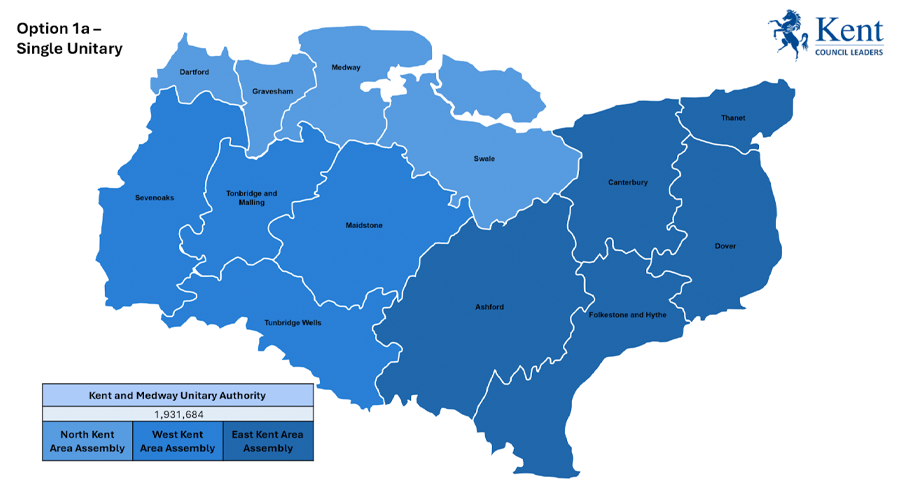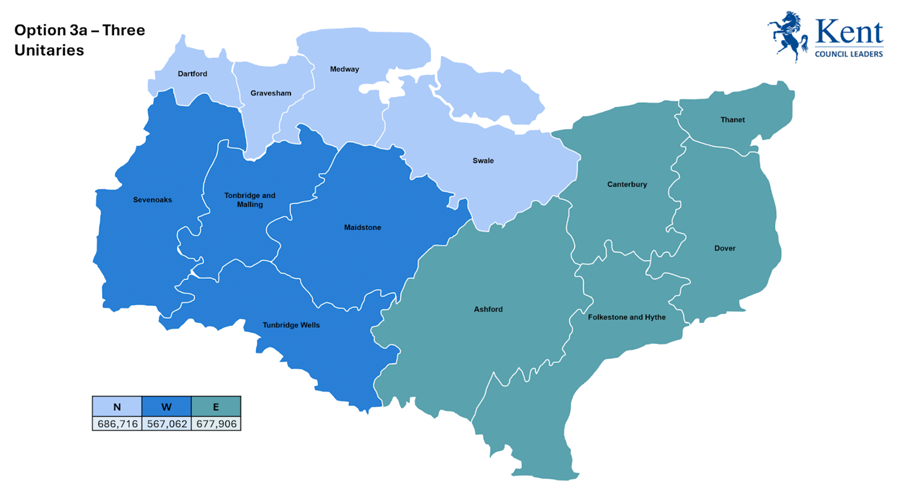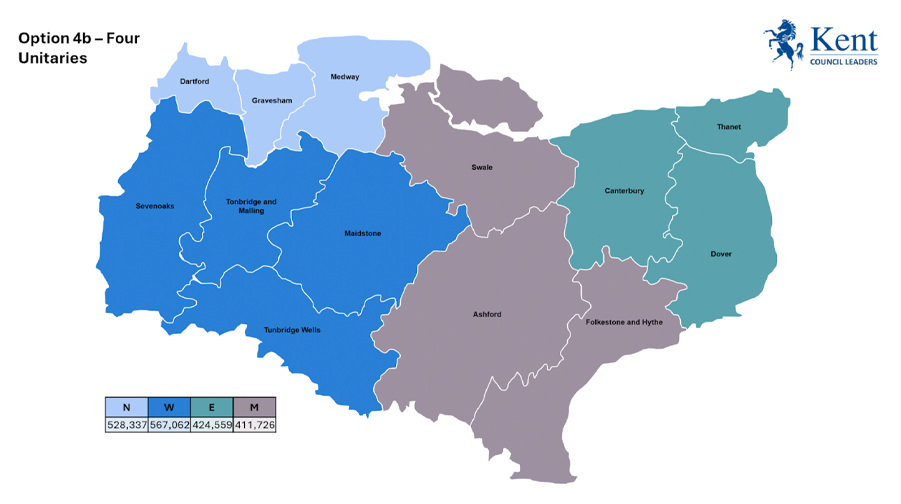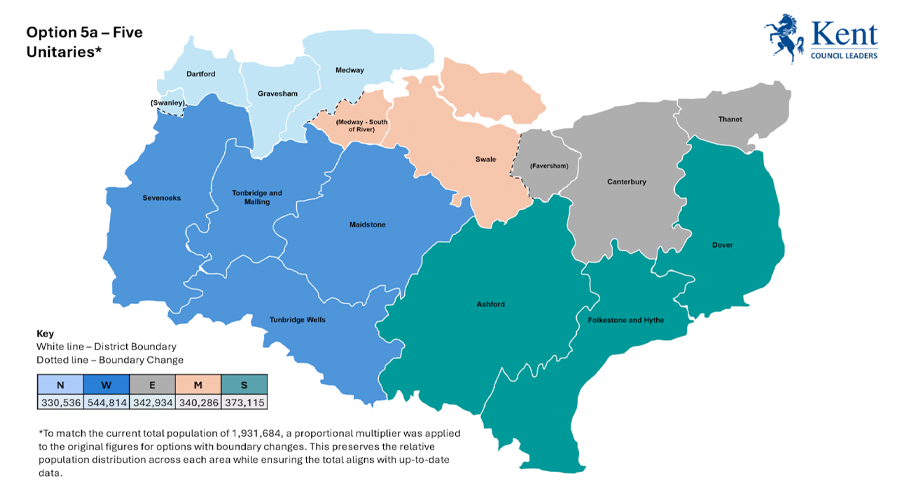Councils across Kent and Medway have now published draft business cases for a possible reshaping of local government. These cases form the basis for formal submissions to the Secretary of State, due by Friday 28 November. This blog post sets out the LGR options, the groupings behind each model, and the choices made by individual councils during November 2025, as well as what it means for Canterbury and the future of local public services in our City.
Why These LGR Options Matter
Local government in Kent is currently split between Kent County Council (KCC) delivering county-wide services and district/borough councils delivering local services such as waste collection and housing.
Under the reorganisation proposals, unitary councils would deliver all services within their area, similar to how Medway Council operates today.
In September, councils selected two options to develop in detail with government funding: Option 3a and Option 4b. Councils were also free to explore and fund alternative proposals using the same dataset.
The Five LGR Options
Below is a concise summary of the LGR options now in circulation and being considered – each option has a link to the business case for further details:
Option 1a – Single Unitary

A single authority for all of Kent and Medway, supported by three area committees:
- North: Dartford, Gravesham, Medway, Swale
- West: Sevenoaks, Tonbridge & Malling, Maidstone, Tunbridge Wells
- East: Ashford, Canterbury, Thanet, Dover, Folkestone & Hythe
Option 3a – Three Unitaries

- North: Dartford, Gravesham, Medway, Swale
- West: Sevenoaks, Tonbridge & Malling, Maidstone, Tunbridge Wells
- East: Ashford, Canterbury, Thanet, Dover, Folkestone & Hythe
Option 4b – Four Unitaries (Existing Boundaries)

Groupings based on existing district borders:
- North: Dartford, Gravesham, Medway
- West: Sevenoaks, Tonbridge & Malling, Maidstone, Tunbridge Wells
- Central: Swale, Ashford, Folkestone & Hythe
- East: Canterbury, Thanet, Dover
Option 4d – Four Unitaries (Boundary Changes)

A four-unitary model that adjusts boundaries to balance population and service patterns.
The draft case proposes redistributed areas of:
- Dartford, Gravesham, Medway, Swale
- Sevenoaks, Tunbridge Wells, parts of Tonbridge & Malling
- Maidstone, Ashford, parts of Tonbridge & Malling, Swale, part of Folkestone & Hythe
- Canterbury, Thanet, Dover, remaining areas of Swale and Folkestone & Hythe
Option 5a – Five Unitaries

A smaller-scale unitary model with boundary changes:
- Dartford, Gravesham, areas of Medway west of the River Medway, Swanley
- Sevenoaks, Tonbridge & Malling, Tunbridge Wells, Maidstone (excluding Swanley)
- Remaining Medway with western Swale (Sittingbourne)
- Eastern Swale (Faversham) with Canterbury and Thanet
- Ashford, Folkestone & Hythe, Dover
What Each Council Has Recommended
Below is the latest approved set of recommendations made by councils in November 2025:
| Authority | Recommended Option |
|---|---|
| Ashford Borough Council | Option 4d – four unitaries with boundary changes |
| Canterbury City Council | Option 4d – four unitaries with boundary changes |
| Dartford Borough Council | Option 5a – five unitaries |
| Dover District Council | Option 4b – four unitaries (no boundary changes) |
| Folkestone & Hythe District Council | Option 3a – three unitaries |
| Gravesham Borough Council | Option 5a – five unitaries |
| Kent County Council | Option 1a – single county-wide unitary |
| Maidstone Borough Council | Option 3a – three unitaries |
| Medway Council | Option 4d – four unitaries with boundary changes |
| Sevenoaks District Council | Option 3a – three unitaries |
| Swale Borough Council | Option 4b – four unitaries (no boundary changes) |
| Thanet District Council | Option 4b – four unitaries (no boundary changes) |
| Tonbridge & Malling Borough Council | Option 3a – three unitaries |
| Tunbridge Wells Borough Council | Option 3a – three unitaries |
What This Means for Kent
The split in preferred LGR options reflects the different political, financial and geographic priorities across the county.
- West Kent is aligned around the three-unitary model
- East Kent is divided between 4b (district-based grouping) and 4d (boundary changes).
- North Kent councils are split between five-unitary and four-unitary models.
- Kent County Council continues to push for a single county-wide unitary, the option with the highest centralisation.
Councils have developed draft business cases (outlined above), next the Secretary of State will review these submissions and decide whether to issue a formal invitation to bring forward statutory reorganisation proposals under relevant legislation.
The Government is expected to confirm by around March 2026 whether it will issue a formal invitation to bring forward statutory reorganisation proposals.
Why Canterbury Is Uniquely Exposed Under Every LGR Option
Canterbury is the only major urban area in Kent that is entirely unparished. This creates a unique risk in any reorganisation.
Related Reading:
Read Dave Wilson’s article setting out the wider context of Kent’s reorganisation and the government process in his update.
1) Loss of local democratic voice
All the LGR options abolish district councils.
If Canterbury remains unparished, the city loses its only local democratic tier.
Other towns already have parish or town councils to protect local interests. Canterbury has none.
2) Larger authorities mean decisions move further away
Every LGR option places Canterbury inside a much larger unitary council.
This means decisions on local services sit:
- further up the chain
- across a wider geography
- with priorities balanced against other towns and rural areas
With no town council, Canterbury has no statutory voice at this level.
3) Risk to local services and assets
In an unparished area, local assets and neighbourhood services can fall between layers.
These include:
- parks and gardens
- community venues
- allotments
- heritage and locally significant assets
- events
- public realm works
- small maintenance budgets and funding
Other towns and villages run much of this through parish and town councils. Canterbury cannot do so unless one is created prior to reorganisation.
4) LGR accelerates the vulnerability
Before LGR, Canterbury’s district council structure gave the city a degree of neighbourhood responsiveness.
After LGR, the nearest decision-makers will be part of a much larger authority.
How Local Groups Are Responding
The Canterbury Society, working closely with the Campaign for Democracy in the Canterbury District (CDCD), is already discussing the way forward. Regardless of which LGR option the government selects, decision-making will move further away from the city and surrounding towns.
This means Canterbury, Whitstable and Herne Bay will need strong, local, democratic structures to make sure community priorities are not weakened as services are absorbed into larger authorities.
The Canterbury Society and CDCD will continue working together to look at how the voice of the city and its neighbouring towns can remain clear, organised and effective during and after reorganisation.
About the Author

Guy Mayhew
Trustee
Guy works on local government governance, service transformation and public sector restructuring, with experience both across Kent and many UK local authorities. He supports the work of the Canterbury Society and the Campaign for Democracy in the Canterbury District (CDCD) on policy, civic representation and the implications of Local Government Reorganisation for Canterbury and its neighbours.

0 Comments